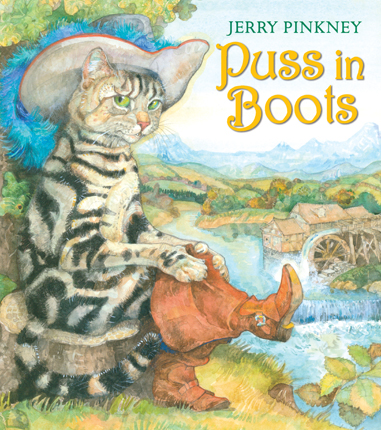Full Text Reviews: School Library Journal - 12/01/2012 PreS-Gr 4—Set in early-18th-century France, this adaptation of Charles Perrault's classic tale is filled with lushly delineated period details, moments of tingling excitement, and playful humor. The protagonist, a handsome silver-tabby British shorthair, boasts elegant black-velvet stripes and intelligent green eyes. Bequeathed to a miller's youngest son, the can-do cat promises that he will prove his worth if provided with appropriate footwear and a draw-string sack. Puss gets to work, cunningly using the sack to hunt game, courteously presenting his prizes to the king, and continually singing the praises of his master (dubbed the Count of Carabas). Cleverly orchestrating a meeting between the young man and the king's lovely daughter, Puss bamboozles the monarch into believing that Benjamin is a man of means and then procures these riches by tricking an evil sorcerer out of his holdings. The story ends with a royal wedding and Puss-now prime minister-contemplating future adventures (the rear endpaper shows him captaining a sailing ship). The text clearly relates the plot with lyrical language and vivacious energy, and the color-pencil and watercolor artwork showcases the period's costumes, architecture, and landscapes. Perfectly timed highpoints (and a foldout page) emphasize the sorcerer's transformations into various animals (in response to Puss's taunting dare), as well as the cat pouncing on the man-turned-helpless-mouse. Accessible and eye-catching, this is a fitting companion to Fred Marcellino's exquisite rendition (Farrar, 1990).—Joy Fleishhacker, School Library Journal - Copyright 2012 Publishers Weekly, Library Journal and/or School Library Journal used with permission. Bulletin for the Center... - 01/01/2013 All the traditional elements of Perrault’s classic cat tale are in place in this elegant retelling, with Pinkney maintaining a slightly mannered tone of dignified restraint while adding a few fresh, original narrative details. For example, Puss’s ultimate triumph involves not an ugly ogre but a “rich and evil sorcerer” who undergoes three transformations-bear, deer, and, finally, mouse-before Puss pounces and overcomes him. The storytelling itself is simplified and streamlined, making the events and characters more comprehensible to a younger audience; the lush graphite, colored pencil, and watercolor illustrations are loaded with detail inspired by other illustrated versions of this story and by the fashions, objects, and landscapes of seventeenth-century France (explained at length in an artist’s note). Pinkney’s Puss is a lithe and handsome “black-and-white silver-tabby British shorthair” who looks perfectly at ease in his upright stance but still retains his catlike movement and expression throughout the pages-particularly stunning is the scene in which Puss leaps, his shadow looming on the wall behind him, upon the sorcerer-turned-mouse. A few compositions are a bit busy, being overloaded with figures in fancy costumes, but overall the visual effect is one of aristocratic charm, and kids will enjoy speculating on Puss’s future, hinted at in the endpaper illustrations of Puss aboard a majestic ship. JH - Copyright 2013 The Board of Trustees of the University of Illinois. Loading...
|



